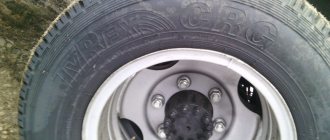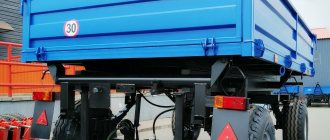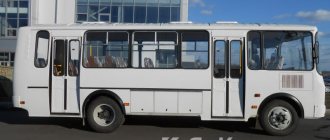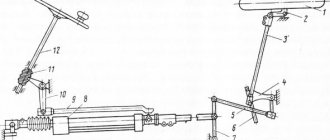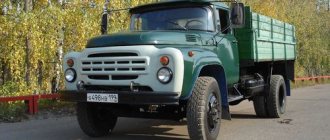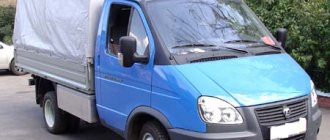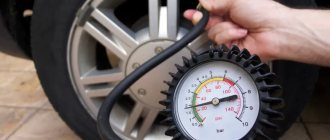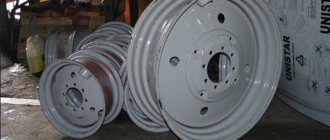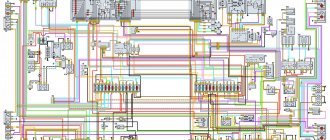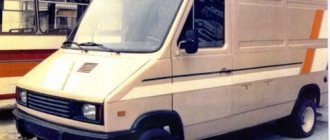Vehicles of the Sobol family are passenger, utility and cargo vehicles.
GAZ-2217 (bus)
GAZ-2752 (van)
GAZ-2310 (with flatbed)
Air pressure in tires, kPa (kgf/cm2)
front wheels: seven-seater bus – 260+10 (2.7+0.1) eleven-seater bus – 260+10 (2.7+0.1) GAZ-2310 and GAZ-2752 – 320+10 (3.3+0 ,1)
rear wheels: seven-seater bus – 270+10 (2.8+0.1) eleven-seater bus – 300+10 (3.1+0.1) GAZ-2310 and GAZ-2752 – 380+10 (3.9+0 ,1)
Please tell me what pressure to pump into the tires of the all-wheel drive SOBOL?
Tire pressure gas sable
Vehicles of the Sobol family are passenger, utility and cargo vehicles.
GAZ-2217 (bus) GAZ-2752 (van) GAZ-2310 (with flatbed)
Air pressure in tires, kPa (kgf/cm2)
front wheels: seven-seater bus - 260+10 (2.7+0.1) eleven-seater bus - 260+10 (2.7+0.1) GAZ-2310 and GAZ-2752 - 320+10 (3.3+0 ,1)
rear wheels: seven-seater bus - 270+10 (2.8+0.1) eleven-seater bus - 300+10 (3.1+0.1) GAZ-2310 and GAZ-2752 - 380+10 (3.9+0 ,1)
Owners of trucking companies often think about the question - what should be the pressure in tires in order to increase their service life and reduce fuel consumption?
Driving a route gazelle at a speed of more than 70 km/h with overinflated tires, and even on a bad road, can lead to overheating and subsequently deformation of the tire. Any deviation from the optimal tire pressure will result in unwanted costs.
Tire and wheel sizes for GAZ Sobol 2022
Wheel bolt pattern parameters
| PCD (number of holes x circle diameter) | 5×139.7 mm |
| Center Hole Diameter (DIA) | 108.5 mm |
| Fasteners | M14 x 1.5 |
| Type of fastener | screw |
| Tires | Discs | PCD | Dia | Pressure |
| 215/65 R16 Factory kit | 6.5Jx16ET45 | 5×139.7 | 108.5 | 2.4 |
| 225/60 R16 Factory kit | 6.5Jx16ET45 | 5×139.7 | 108.5 | 2.4 |
| 255/45 R18 Tuning | 7Jx18 ET35 | 5×139.7 | 108.5 | 2.4 |
What wheel sizes does the manufacturer recommend to install?
The vehicle tire marking 215/65 R16 is deciphered as follows:
Using the recommended tire sizes will help you avoid problems with handling, safety and other difficulties. What non-standard sizes can be supplied? Refer to the table; it indicates possible acceptable alternative sizes for tuning. Although there are other options that we have not described in the table. For example, wider discs of the same diameter. Or install wheels of the same width, but with a larger diameter, which is quite popular among car owners. The choice of discs is huge; you can find copies with the same parameters, but with an overhang 1-2 millimeters more or less. It is not possible to list all the options.
At the same time, the bolt pattern for all types of wheels is the same - 5 × 139.7. Thus, all the disks are fastened with five bolts and the distance between them is exactly one hundred and thirty-nine point and 70 hundredths millimeters. The car's hub diameter is 108.5 mm.
Standard tire pressure is 2.4 MPa.
Wheel bolt pattern parameters
| PCD (number of holes x circle diameter) | 5×139.7 mm |
| Center Hole Diameter (DIA) | 108.5 mm |
| Fasteners | M14 x 1.5 |
| Type of fastener | screw |
| Tires | Discs | PCD | Dia | Pressure |
| 225/75 R16 Factory kit | 6.5Jx16ET45 | 5×139.7 | 108.5 | 2.4 |
| 255/45 R18 Tuning | 7Jx18 ET35 | 5×139.7 | 108.5 | 2.4 |
What wheel sizes does the manufacturer recommend to install?
The vehicle tire marking 225/75 R16 is deciphered as follows:
Using the recommended tire sizes will help you avoid problems with handling, safety and other difficulties. What non-standard sizes can be supplied? Refer to the table; it indicates possible acceptable alternative sizes for tuning. Although there are other options that we have not described in the table. For example, wider discs of the same diameter. Or install wheels of the same width, but with a larger diameter, which is quite popular among car owners. The choice of discs is huge; you can find copies with the same parameters, but with an overhang 1-2 millimeters more or less. It is not possible to list all the options.
At the same time, the bolt pattern for all types of wheels is the same - 5 × 139.7. Thus, all the disks are fastened with five bolts and the distance between them is exactly one hundred and thirty-nine point and 70 hundredths millimeters. The car's hub diameter is 108.5 mm.
Standard tire pressure is 2.4 MPa.
Wheel bolt pattern parameters
| PCD (number of holes x circle diameter) | 5×139.7 mm |
| Center Hole Diameter (DIA) | 108.5 mm |
| Fasteners | M14 x 1.5 |
| Type of fastener | screw |
| Tires | Discs | PCD | Dia | Pressure |
| 185/75 R16 Factory kit | 6.5Jx16ET45 | 5×139.7 | 108.5 | 2.4 |
| 215/65 R16 Factory kit | 6.5Jx16ET45 | 5×139.7 | 108.5 | 2.4 |
What wheel sizes does the manufacturer recommend to install?
The vehicle tire marking 185/75 R16 is deciphered as follows:
Using the recommended tire sizes will help you avoid problems with handling, safety and other difficulties. What non-standard sizes can be supplied? Refer to the table; it indicates possible acceptable alternative sizes for tuning. Although there are other options that we have not described in the table. For example, wider discs of the same diameter. Or install wheels of the same width, but with a larger diameter, which is quite popular among car owners. The choice of discs is huge; you can find copies with the same parameters, but with an overhang 1-2 millimeters more or less. It is not possible to list all the options.
What problems can arise if the tire pressure is incorrect?
The tire pressure on a Gazelle car must comply with standard values. If there is a shortage or excess, unnecessary costs are possible.
Consequences of under-inflated tires:
- Fuel consumption increases significantly as more power is required to get started;
- The service life of tires is reduced as the diameter of contact between the tire and the road increases;
- Large noise emitted from tires;
- Reduced controllability, increased acceleration and reaction time for maneuvers.
Excessive pressure in car tires also brings a lot of inconvenience. Among them are:
- Ride comfort decreases. Sensitivity to both potholes and small cracks in asphalt increases. In addition, the smallest imperfections on the road will be felt;
- If you hit a pothole, the likelihood of a “hernia” appearing on the tire increases significantly;
- The braking distance almost doubles.
According to the regulatory documents that come with the supplied tires, the tire pressure should not exceed 3 atmospheres. In reality, some Gazelle owners inflate their tires to a level of 3.3-3.5. This indicator reduces ride comfort. But it’s still worth trying and choosing the most acceptable pressure for yourself.
Manufacturer's requirements
The manufacturer, in accordance with operating conditions, advises increasing the pressure in Gazelle 3302 tires to 2.9-3.0 atmospheres. The same standard has been established for previous Gazelle brands. But in reality this is not the final value. This is because the tire pressure of an empty minibus and a fully loaded van should be different. Therefore, a table was developed with instructions: what should be the pressure in Gazelle tires. It took into account: the vehicle load and the type of tires used according to the car brand.
For Gazelle models intended for transporting cargo and passengers, higher tire pressures are required, since they have larger equipment. A Sobol brand car uses tires designed for more comfortable trips. As a result, the pressure in Gazelle Business tires is slightly underestimated, because this gives additional driving comfort and does not lead to danger for the tires during operation.
Gazelle Next became the next model after business class. It has a more comfortable and safe cabin with hydraulic power steering. The tire pressure of Gazelle Next is significantly different from the specified values of its predecessors.
According to the documents, the pressure in the front wheels should be in the range of 3.6-3.8, and in the rear 3.7-3.9 atmospheres.
Tire pressure, according to observations
A huge number of drivers who use the Gazelle every day have, through daily observations, determined, each for themselves, the appropriate tire pressure. Which is acceptable both in terms of tire service life and fuel consumption.
So what tire pressure on a Gazelle should correspond to a comfortable ride and minimize costs? The choice of pressure is determined by many factors: road, weather, weight of the cargo being transported, etc. Owners of Gazelles 3302 and 2705 stopped at 3.5 atmospheres.
This is enough for the necessary rigidity and a confident ride, both when fully loaded and with an empty interior. In addition to this, the wheels must be in perfect condition and the tires must be in good condition. After all, even a brand new tire can lose pressure up to 0.4 atmospheres every month.
Taking into account the condition of the roads and the workload of passenger Gazelles, drivers chose the optimal pressure and pumped the wheels to 3.0-3.2 atmospheres.
There are many reasons that can influence the choice of acceptable tire pressure. They are determined by the performance characteristics and characteristics of the rubber itself.
There is a marking on the side indicating:
- Maximum permissible tire pressure level;
- Permissible weight that tires can support at a certain speed;
- Permissible vehicle load.
All wheels must have the same pressure. An error of 0.7 atmospheres between axles and no more than 0.3 atmospheres on the wheels of one axle is allowed. It is recommended to check tire pressure every two weeks.
Tire sizes for Sobol and Barguzin: what to install
Cars Sobol and Barguzin differ from cars of the Gazelle family in having a lower load capacity, which is why the tires initially used on them were non-reinforced (without the “C” index) in size 215/65R16. But the actual load capacity is no less than that of a “gazelle”; as a result, tires of the same sizes as those of Gazelles began to be used on cars.
| 185/75R16C |
| 195R15C |
| 205/70R16 |
| 215/65R15 |
| 225/65R16 |
| 235/60R16 |
The rims on Sobols and Barguzins are wider than those on Gazelles, so tires of size 175R16C cannot be used, and since there are no twin wheels on the rear axle, the width of the tires can vary from 185 to 245 mm, depending on your desire.
Tires for Gazelles: Russian, imported or Chinese
The Russian tire market offers a huge range of models and every owner of a Gazelle or Sable will be able to choose one to suit every taste and wallet size. Absolutely all tire manufacturers produce models with standard sizes for Gorky cars: both Russian: Amtel (aka Kirov Tire Plant), Cordiant (Omsk and Yaroslavl Tire Plants), tires from the Altai Tire Plant, and the world's leading manufacturers Michelin, Bridgestone, GoodYear, etc. And in the last few years, tires from Chinese manufacturers Aeolus, Triangl, Boto and others have become very popular.
New or used?
Is it possible to buy used tires for Gazelle? This question is often asked by drivers and the answer is definitely NO. Cars of the Gazelle family are light-duty, low-tonnage vehicles and their operation (for the most part) is the transportation of goods, in most cases in violation of the permissible weight. Therefore, after use on these vehicles, all tires have damage, and not necessarily external damage. Even with good tread, tires are likely to have internal damage.
You can buy used tires for Sobol and Barguzin, if they are not light trucks (there is no “C” index in the standard size), but the probability of buying good tires is 50/50 (either good or not).
Summer, all-season, winter studded
The majority of car owners (about 90%) prefer to operate their cars on universal, all-season tires, citing the fact that the Gazelle is a truck. But it is worth noting that in recent years the trend has been changing, especially in the central and northern regions of Russia. Many gazelle drivers prefer to have 2 sets of tires: for winter and summer use. And in the Krasnodar region you can always drive with summer or all-season tires, while in the Arkhangelsk and Leningrad regions many people install studded tires on Gazelle for the winter period. Studded tires are produced by both Russian manufacturers such models: K-156, Ya-462, Forvard-156, and foreign ones - Michelin Agilis X-Ice North, Tigar Cargo Speed Winter, GoodYear Cargo UltraGrip. Not a single tire model (except for models from Nokian) is studded at the factory.
Tire pressure on Gazelle, Sobol, Barguzin
In the technical documentation, the recommended tire pressure is 2.9 atm. But in practice everything is not so simple. On many forums you can find values from 3.5 to 4.2 atm. A pressure of 2.9 atm can only be used if the car is not guaranteed to be overloaded, but this does not happen with these cars. According to experience, the optimal pressure in the wheels of Gazelles, Sobolev, and Barguzinov is from 3.4 to 3.9 atm.
Tube or tubeless
What tires to ride on (tube or tubeless), each driver decides for himself. And if earlier the answer was clear - tube tires for the Gazelle are better (bad rims, bad roads), now the trend is changing: the roads are getting better, and the quality of the rims has become higher. The majority (about 65%) still choose tubed tires, but over time tubed tires will go away. They are no longer used in passenger vehicles; in trucks they are used in less than 20% of vehicles... Tubeless tires are more practical and cheaper (the tube costs more than 10% of the cost of the tire).
Mileage: how long do tires last?
Tire mileage depends not so much on the quality of the rubber itself (although this is a very important factor), but on their operating conditions. On average, according to driver reviews, wheel mileage varies from 50-70 to 100-120 thousand km, and it cannot be said with certainty that some travel more and others less. Of course, Michelin tires have a higher mileage than Triangl, but the cost differs significantly, and even Michelin tires are not insured against an “inadequate” driver.
Prices for popular tires for cars Gazelle, Sobol, Gazelle Next, Barguzin, Gazelle Business
| 2900-00 | ||
| 175R16C | Kama-218 | 3000-00 |
| 175R16C | BI-522 | 3000-00 |
| 175R16C | K-135 | 2500-00 |
| 185/75R16C | Forward A12 | 2500-00 |
| 185/75R16C | K-156 (chambered with camera) | 2800-00 |
| 185/75R16C | K-156 (tubeless) | 2700-00 |
| 185/75R16C | K-170 (camera with camera) | 2800-00 |
| 185/75R16C | K-170 (tubeless) | 2650-00 |
| 185/75R16C | VS-22 | 2300-00 |
| 185/75R16C | VL-54 | 2600-00 |
| 185/75R16C | Forward-156 (chamber with camera) | 2400-00 |
| 185/75R16C | Forward-156 (tubeless) | 2300-00 |
| 185/75R16C | Forward-170 (chamber with camera) | 2300-00 |
| 185/75R16C | Forward-170 (tubeless) | 2200-00 |
| 185/75R16C | Forward-301 (chamber with camera) | 2350-00 |
| 185/75R16C | Forward-301 (tubeless) | 2000-00 |
| 185/75R16C | Kama-301 | 3050-00 |
| 185/75R16C | Cordiant Business CA-1 (chamber with camera) | 2900-00 |
| 185/75R16C | Cordiant Business CA-1 (tubeless) | 2750-00 |
| 185/75R16C | S-156 | 2400-00 |
| 185/75R16C | NK-131 Kama-Euro | 2950-00 |
| 185/75R16C | Kama Euro-520 (studded) | 3800-00 |
| 195R16C | K-139 | 2750-00 |
| 3200-00 | ||
| 185/75R16C | Pirelli Chrono 2 | 4220-00 |
| 185/75R16C | Dunlop EconoDrive | 4500-00 |
| 185/75R16C | GoodYear Cargo G26 | 4600-00 |
| 185/75R16C | BF Goodrich Activan Go | 4650-00 |
| 185/75R16C | Headway HR601 | 2300-00 |
| 185/75R16C | Yokohama RY818 | 4600-00 |
| 185/75R16C | Michelin Agilis Alpin (winter) | 6350-00 |
| 185/75R16C | GoodYear Cargo UltraGrip (studded) | 4550-00 |
| 185/75R16C | Maxxis UE168N | 3850-00 |
| 185/75R16C | Ovation V-02 | 2250-00 |
| 185/75R16C | Tigar Cargo Speed Winter (studded) | 3850-00 |
| 185/75R16C | Hankook Radial RA08 | 3450-00 |
| 185/75R16C | Michelin Agilis X-Ice North (studded) | 2900-00 |
| 185/75R16C | Hakka C Cargo | 4050-00 |
| 185/75R16C | Michelin Agilis+ | 5450-00 |
| 185/75R16C | Rotalla RF09 | 2550-00 |
| 185/75R16C | Suntek STK-VAN | 2550-00 |
| 185/75R16C | Yokohama Y354 | 4300-00 |
| 185/75R16C | Nexen CP321 | 3300-00 |
| 185/75R16C | Tigar Cargo Speed | 3500-00 |
Page 19
– lateral inclination of the kingpin
– longitudinal inclination of the kingpin
– wheel toe-in, mm
Air pressure in tires of 4×2 type vehicles, kPa (kgf/cm
260+10 (2.7+0.1) – for auto. GAZ-2217 and mod. 320+10 (3.3+0.1) – for GAZ-2310, GAZ-2752 with tires 185/75 R16C 250+10 (2.6+0.1) – for GAZ-2310, GAZ-2752 with tires 215/65 R15
270+10 (2.8+0.1) – for auto. GAZ-2217 and mod. for 6 passenger seats 300+10 (3.1+0.1) – for cars. GAZ-2217 and mod. for 10 passenger seats 380+10 (3.9+0.1) – for GAZ-2310, GAZ-2752 with tires 185/75 R16C 290+10 (3.0+0.1) – for GAZ-2310 , GAZ-2752 with tires 215/65 R16
Air pressure in tires of 4×4 type vehicles, kPa (kgf/cm
Note:
The air pressure in the tires of each axle must be the same, according to the specified values.
Calculation of the recommended value
How to use the calculator?
Gentlemen, please advise the correct pressure in the tires of the passenger Sable, I don’t carry loads, well, sometimes we’ll ride with 2-6 people. Thank you.
Added after 1 minute 57 seconds This is what they write on the Internet:
Front 3 - 3.3 atm, rear 3.9 atm. For domestic purposes. tires should have the index “C” - (185-75-R16C). With less pressure on the front ones, the tire rubber will “eat.” Be sure to check your blood pressure (!) at least once a week.
What pressure should the tires be?
The tire pressure of your car should be checked at least once a week. Modern tubeless tires are very sensitive to pressure, so reducing or increasing it in a tire by just 15-20% can increase its wear by up to 30% and negatively affect driving safety. Potholes, speed bumps, curbs - driving over them causes your tire pressure to drop.
We will tell you what pressure should be in a car's tires in winter and summer, and how changing it affects the car's behavior on the road and tire tread wear.
Below in the text you will find tables of tire pressures for cars by brand and wheel size, which present the most popular car models in Russia.
And it will be much easier for you to understand all kinds of symbols on wheels if you have at hand a decoding of the tire markings (indices of design, speed, tire load, etc.).
table by car make and tire size
Insufficient attention to detail regarding the technical condition of the car is one of the problems of inexperienced drivers. Many of them do not think about what pressure should be in the tires of a vehicle. Meanwhile, this parameter directly affects the car’s handling and even its level of fuel consumption.
Basic information about tire pressure and how to measure it
Optimal tire pressure is not only about driving safety, but also about driver comfort when driving.
Therefore, competent drivers carefully monitor this parameter, along with the oil level, the required amount of brake fluid, and the battery charge level. The relevance of pressure control is also due to the fact that when it increases or decreases, fuel consumption increases and the rate of tire wear increases. The main purpose of tires is to provide traction with the road surface. If the pressure is not sufficient, the tread wears out faster due to an increase in the contact area between the rubber and the asphalt. Additionally, uneven abrasion of the protectors occurs, moving to the outer edge. If the tire pressure is insufficient, there is a risk of tire puncture and wheel rim deformation.
A tire that is too hard negatively affects the suspension, transferring shock from the slightest bump on the road to it. As a result, rapid wear of shock absorbers, silent blocks, and springs occurs. The vehicle's handling suffers, especially on sharp turns and wet asphalt, as the tires “slip.”
Monitoring the optimal tire pressure “by eye” or by kicking the wheel is not acceptable. Although it is the type of wheel that can push the driver to unscheduled measurements with special instruments. But even if the wheels are visually in good condition, measurements are taken during seasonal wheel changes and before long trips. You should also measure tire pressure if you suspect a decrease in tire pressure while driving. The driver can feel the decrease in pressure by the behavior of the car while driving.
There is special pressure gauge equipment for measuring tire pressure. Many gas stations are equipped with pressure gauges. Special equipment is required in tire shops and service stations.
Drivers who prefer to service their car themselves purchase the following types of pressure gauges:
Important. The pressure is measured before leaving the road, on cold tires. All wheels are checked to ensure accurate alignment of all four.
Pressure control chart
Ideally, tire pressure is checked before each time you leave the garage. But not every driver has time for such a measurement.
Therefore, experts recommend the following frequency of control measurements:
Optimal tire pressure
Tire pressure is a value that depends on many factors:
Specific indicators will depend on the combination of all these factors, so the pressure in the tires of a passenger car is not a constant value. At the same time, car manufacturers indicate pressure standards for each car model in the operating manual.
Optimal car tire pressure
The main task of car tires is to provide effective traction between the car and the road. With normal air pressure in the tire, the load in the contact patch of the wheel with the road is distributed evenly, due to which tire wear occurs evenly, the car handles well and fuel consumption is within normal limits.
There are three possible scenarios in which the tire pressure will not be optimal:
- Increased pressure (tires overinflated);
- Low pressure (tires underinflated);
- Different pressure in all wheels.
Check the tire pressure with a special tire pressure gauge. This should only be done on cold tires, that is, before leaving the parking lot or garage.
If deviations from the normal pressure are detected in any of the tires (see the table below for what pressure should be in the tires of your passenger car), such a wheel must either be inflated or excess air released from it - that is, the pressure must be adjusted to norm. In one of our articles, we already talked about which car compressor is best for inflating tires.
It is worth noting that the tire pressure in winter should be exactly the same as in summer. But due to the sharp temperature change, in winter, monitoring the air pressure in the wheels needs to be approached more responsibly.
It is better to inflate your tires outside. Also, do not forget to check the tire pressure when there are significant changes in ambient temperature, and if necessary, adjust it:
- if it gets cold outside, the pressure in the tires will decrease,
- and when it gets warmer, it will rise.
It should also be remembered that while the car is moving, the tires heat up, the air in them expands, and the pressure increases, and the handling and braking properties change.
Increased tire pressure
With increased tire pressure, the load at the point of contact of the wheel with the road acts to a greater extent on the central part of the tire tread, thereby causing uneven wear of the tire.
On overinflated wheels, the car brakes worse! This happens because if the tires are overinflated, the contact patch with the road decreases, which means the friction force that keeps the car from sliding decreases. At the same time, the braking distance increases noticeably.
In just twenty minutes of driving, taking turns as aggressively as possible, the pressure in the car’s tires can increase by 0.5 atmospheres. And on long trips at high speed, the pressure in the tires can increase to 4-5 atmospheres. And modern tires are designed for this.
But if the tire has a hernia or cut, it can heat up and explode while driving. But on the road it’s a disaster.
Low tire pressure
Wheels lowered to just half an atmosphere change the behavior of the car and become unusable much earlier than expected. When the pressure is low, the load on the tire surface is distributed unevenly. In this case, the sidewalls of the tire where the tire contacts the road are subject to increased wear.
The sidewalls of flat tires are softer and bend when you turn the steering wheel. The trajectory of the wheel and tire do not match, so the car responds to the steering wheel late.
Moreover, if the tire pressure is reduced, the wheel may even come off during a sharp turn. Therefore, it is very important to regularly check the tire pressure and maintain it within the normal range.
This is especially true in winter, since in cold weather the tire pressure can easily drop by 0.3 (or even 0.5) atmospheres.
It is also worth keeping in mind that low air pressure in the wheels leads to increased fuel consumption. Just in case, we remind you that our website has an excellent selection of tips on how to reduce fuel consumption in a car - be sure to read it, you will probably find something new for yourself.
Different pressure in car tires
The most common situation among drivers is when the pressure in all wheels is different. There can be many reasons, for example:
- Faulty spool valves;
- Uneven tire wear;
- Or perhaps you caught a nail with the wheel.
During emergency braking, in this case, the coefficient of road adhesion between inflated and lowered wheels will be different, which with a high degree of probability will lead to the car skidding or turning across the road.
If the car starts to pull even a little to the side, there is a reason to check how the tires are inflated. And remember that tires don’t last forever. Even very good tires need care.
General background information
Ranges of possible values for tires and wheels GAZ Sobol 2019.
Wheel disks
| Diameter | 16″–18″ |
| Width (inches) | 6.5–7 |
| Reach (mm) | 35–45 |
| Drills | 5×139.7 |
Expert advice
When choosing tires for a car, you must first follow the manufacturer's instructions. Ask yourself a few questions.
The answers to these and similar questions will help determine which tire parameters you need to pay special attention to.
How to choose the right wheels for GAZ Sobol 2022?
The choice depends on financial capabilities. However, it should be borne in mind that the quality of the road surface on which you have to drive every day must also be taken into account.
So, if it gets into a hole, a stamped disk will bend and will not cause harm to the tire, but a forged or cast one can cut it. There is a possibility that the cast disc may burst or crack.
It should also be noted that repairing “stamping” wheels is cheaper than repairing cast or forged wheels. But wheels with high-quality cast and forged disks kill the suspension less, because lighter and have more perfect geometry (better balanced).
The same wheels may or may not rub with tires on the same car - wheel alignment adjustment will help here.
What is the tire pressure?
It is the driver's responsibility to constantly monitor tire pressure. This will avoid standard problems associated with vehicle operation. An abnormal pressure value often causes:
Often the car owner independently reduces the pressure in the wheels of his own vehicle. This reduces the load on the suspension, and the car “passes” various road irregularities an order of magnitude easier. But it is worth noting: a decrease in pressure even by 0.1 MPa leads to serious problems. The main ones include:
An overinflated wheel causes no less problems. The central part of the cylinder begins to wear off quickly. In addition, at ambient temperatures of more than 60 degrees Celsius, the tire may simply explode. Which will lead to driving into the oncoming lane.
© 2019-2021 Avto Sprav. Directory of factory parameters of disks and tire sizes.
Attention! Our catalog is an information resource and does not guarantee full compliance of the proposed dimensions with your car. Make sure that your car has wheels of the appropriate radius.
What is the tire pressure on a Gazelle?
Tire pressure on gazelle
Which should be Gazelle tire pressure
January 5, 2014 Kolesnikov
Tire pressure of a Gazelle “How it should be
? This question may have been asked by anyone who had to drive this car. It would seem so important that the car be a little hard on impact or be a little uncomfortable to drive. Yes, this is not scary for some models, but not for the Gazelle. If your tire pressure is not correct, you will have a lot of problems. Firstly, the “rubber” wears out quickly, almost wears out before your eyes. Secondly, the car will consume a lot more fuel, which, of course, will hit your pocket.
Prices for popular tires for cars Gazelle, Sobol, Gazelle Next, Barguzin, Gazelle Business
| 2900-00 | ||
| 175R16C | Kama-218 | 3000-00 |
| 175R16C | BI-522 | 3000-00 |
| 175R16C | K-135 | 2500-00 |
| 185/75R16C | Forward A12 | 2500-00 |
| 185/75R16C | K-156 (chambered with camera) | 2800-00 |
| 185/75R16C | K-156 (tubeless) | 2700-00 |
| 185/75R16C | K-170 (camera with camera) | 2800-00 |
| 185/75R16C | K-170 (tubeless) | 2650-00 |
| 185/75R16C | VS-22 | 2300-00 |
| 185/75R16C | VL-54 | 2600-00 |
| 185/75R16C | Forward-156 (chamber with camera) | 2400-00 |
| 185/75R16C | Forward-156 (tubeless) | 2300-00 |
| 185/75R16C | Forward-170 (chamber with camera) | 2300-00 |
| 185/75R16C | Forward-170 (tubeless) | 2200-00 |
| 185/75R16C | Forward-301 (chamber with camera) | 2350-00 |
| 185/75R16C | Forward-301 (tubeless) | 2000-00 |
| 185/75R16C | Kama-301 | 3050-00 |
| 185/75R16C | Cordiant Business CA-1 (chamber with camera) | 2900-00 |
| 185/75R16C | Cordiant Business CA-1 (tubeless) | 2750-00 |
| 185/75R16C | S-156 | 2400-00 |
| 185/75R16C | NK-131 Kama-Euro | 2950-00 |
| 185/75R16C | Kama Euro-520 (studded) | 3800-00 |
| 195R16C | K-139 | 2750-00 |
| 3200-00 | ||
| 185/75R16C | Pirelli Chrono 2 | 4220-00 |
| 185/75R16C | Dunlop EconoDrive | 4500-00 |
| 185/75R16C | GoodYear Cargo G26 | 4600-00 |
| 185/75R16C | BF Goodrich Activan Go | 4650-00 |
| 185/75R16C | Headway HR601 | 2300-00 |
| 185/75R16C | Yokohama RY818 | 4600-00 |
| 185/75R16C | Michelin Agilis Alpin (winter) | 6350-00 |
| 185/75R16C | GoodYear Cargo UltraGrip (studded) | 4550-00 |
| 185/75R16C | Maxxis UE168N | 3850-00 |
| 185/75R16C | Ovation V-02 | 2250-00 |
| 185/75R16C | Tigar Cargo Speed Winter (studded) | 3850-00 |
| 185/75R16C | Hankook Radial RA08 | 3450-00 |
| 185/75R16C | Michelin Agilis X-Ice North (studded) | 2900-00 |
| 185/75R16C | Hakka C Cargo | 4050-00 |
| 185/75R16C | Michelin Agilis+ | 5450-00 |
| 185/75R16C | Rotalla RF09 | 2550-00 |
| 185/75R16C | Suntek STK-VAN | 2550-00 |
| 185/75R16C | Yokohama Y354 | 4300-00 |
| 185/75R16C | Nexen CP321 | 3300-00 |
| 185/75R16C | Tigar Cargo Speed | 3500-00 |
Low-tonnage vehicles of the Gorky Automobile Plant have long been, and rightfully so, the most popular light trucks in Russia. The plant has a whole range of models: Gazelle, Gazelle Business, Gazelle Next, Sobol, Barguzin. The choice of tires for these cars is large; the tire market offers a large selection of tires for Gazelle in various sizes and with different tread patterns. We will tell you how to choose the right one in this article.
Problems arising from pressure mismatch
Tires must be inflated correctly. Just as under-inflated tires cause inconvenience, so too do over-inflated ones.
The main problems that arise with underinflated wheels:
- increased gasoline consumption, as more energy is required to move the car;
- abrasion of tires on asphalt increases, since the contact patch with the road surface is larger;
- noise from tire friction on the road increases;
- car control deteriorates, acceleration time and turn response increase.
Overinflated wheels also bring a lot of inconvenience. The difficulties in handling a car with overly inflated wheels are as follows.
- Ride stiffness. You will feel not only potholes on the road, but even small pebbles.
- If you fall into a hole at speed, part of the wheel may swell - a hernia.
- The braking distance increases.
Manufacturer's requirements
The GAZ plant recommends setting the pressure in the tires of the GAZelle-3302 truck to 2.9 atmospheres. However, this recommendation applies to all early GAZelle cars from this manufacturer. In general this is not true. The pressure does not have to be fixed and the same for an empty passenger car and a loaded van. Therefore, there is a table of tire pressures for a GAZelle car, which takes into account both the vehicle load and the type of tires used.
Cargo and cargo-passenger models require higher tire pressures, as they have a larger curb weight. Vehicles of the Sobol type use a slightly different type of tire and are more designed for softer transportation. Therefore, the pressure standard in business class GAZelle tires is lower, as this provides additional comfort.
Such parameters are designed specifically for this type of car, and therefore do not create risks for tires during use. This also applies to a relatively new class of cars produced by the GAZ automobile concern since 2010 - “GAZelles” Business. They are characterized by increased comfort, a more powerful engine and improved handling.
In 2013, the GAZ automobile plant began production of a new type of light-duty utility vehicles - GAZelle-NEXT. They became a development of the GAZelle Business, with a more comfortable and safe cabin, power steering and front suspension with independent springs. Externally, it is also quite different from its predecessors and rather resembles a Mercedes car. The pressure in GAZelle-NEXT tires differs from the average values of its predecessors.
Parameters obtained experimentally
Drivers who often use GAZelle cars for work or for personal needs have determined the optimal parameters for themselves, which ensure a comfortable and safe ride in the car. Most drivers inflate their wheels to 3.5 atmospheres. Most often these are those who drive GAZelle-3302 and GAZelle-2705. This ensures a fairly rigid but confident ride both when the cabin is fully loaded with passengers or the body, and during empty flights.
Drivers of passenger minibuses (simply “minibuses”) know how much to pump the wheels of a GAZelle for a comfortable ride on less than ideal roads in Russian cities. Since the suspension of such cars is quite rigid, the tires should not be inflated to a “rock” state. Minibus taxi drivers, in their own words, pump the wheels to a “three-point state,” that is, to a pressure equal to 3 atmospheres.
Factors influencing the choice of tire pressure are determined by both operating conditions and technical characteristics of the rubber.
- Tires must have markings indicating the maximum load that the rubber can withstand.
- An important factor will be the estimated maximum load of the car: how many people will be packed into the cabin or what type of cargo will be transported.
- All wheels must be inflated evenly. Differences in values between the axes should not exceed 0.8 atmospheres. Between the wheels of one axle - no more than 0.3 atmospheres.
- It is necessary to check the tire pressure with a pressure gauge at least once every two weeks, since the natural loss is 0.4 atmospheres per month.
Interesting Facts
Over the long history of GAZelle production at the Gorky Automobile Plant, many interesting events have occurred. Some of them relate to the wheels of this car.
- An all-terrain vehicle with low-pressure tires was created on the basis of the GAZelle car (be sure to read the article about all-terrain vehicles with low-pressure tires). The diameter of its wheels is 24 inches. The width of this tire is 1,300 mm.
- The Tetris game is built into the dashboard of the GAZelle-NEXT car.
- In 2014, the GAZ plant opened a branch in the Turkish city of Sakarya, where cargo-passenger models of these vehicles are produced.
- The NEXT model has a claimed top speed of 134 km/h, but in reality the car can reach higher speeds.
- The declared resource of the GAZelle-NEXT engine is 500,000 km, that is, it is a half-million-dollar engine.
- GAZ is developing electric vehicles based on the GAZelle, as well as unmanned vehicles.

